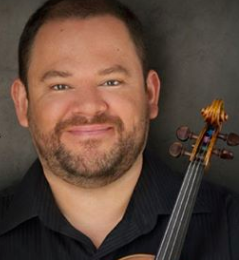Distinguished Concerts International New York (DCINY) presents Jorge Ávila in Review
Jorge Ávila, Violin; Adrienne Kim, Piano
Weill Recital Hall at Carnegie Hall, New York, NY
September 23, 2019
A splendid recital took place this Monday featuring violinist Jorge Ávila with pianist Adrienne Kim under the auspices of Distinguished Concerts International New York (DCINY). Anyone who has heard Mr. Ávila in his longtime role as concertmaster of the Distinguished Concerts Orchestra knows that he is a pro in that capacity – neither jangling ringtones nor fainting singers can ruffle him. His steady playing in countless orchestras (including pit orchestras) might almost lead one to expect the offhand, workaday sound that besets giggers, but such was definitely not the case here. Mr. Ávila is quite the soloist (with a healthy list of solo credentials to match – see http://jorgeavilamusic.com), and his commitment to this program of violin masterworks – Beethoven, Schumann, Chausson, and more – was clear.
Mr. Ávila and Ms. Kim opened with Beethoven’s Sonata for Piano and Violin No. 5 (F major, Op. 24 posthumously nicknamed the “Spring Sonata”). The balmy first movement opened with a particularly sweet violin tone and sensitive piano collaboration. Though there were moments where this listener found the violin sound perhaps a bit too robust, or the piano not enough (m. 11 and similar spots, where the melody switches instruments), such balance quibbles are somewhat subjective. The mutuality of phrase and rhythm throughout was that of a duo with many years of playing together. High points included the Scherzo’s trio section, timed with split-second togetherness and polish, and the fourth movement, Allegro ma non troppo, a final smile from Beethoven.
The premiere of a new work by Nic Scherzinger (b. 1968) followed. Entitled Imprint, it was dedicated to Mr. Ávila and Ms. Kim, and according to the composer is a short “song without words.” As Mr. Scherzinger explains it, “When I began working on this piece pianist Adrienne Kim suggested the title Imprint since Adrienne and Jorge have been performing together for so long. As chamber musicians, there is a certain “imprint” that performers make on each other that can only happen with time and experience, which I try to capture musically in this piece. When the aria begins, the piano and violin start as two completely different individuals, but as the music progresses, they slowly come together, having made imprints on each other.” The title and program notes led this listener somehow to expect more perceptible interchange of roles or musical material than one was able to grasp in a first hearing, but that said, the piece was beautifully atmospheric, combining long-breathed violin lines with an undulating piano bass, both parts gaining intensity throughout the well-paced journey.
Chausson’s expansive Poème for Violin and Piano, Op. 25 (1896) concluded the first half. This quasi-concerto, inspired by a Turgenev love story and the wizardry of the violinist Eugène Ysaÿe, is lush and extravagant. Violin technique is exploited to the hilt, from dazzling double-stops to stratospheric trills, and Mr. Avila seemed to relish it all. He was persuasively expressive, with a flexibility and variety in his vibrato that helped convey the musical message of each distinct phrase. More challenging, of course, is simulating the multitude of colors and timbres of the work’s orchestral origins, and to that end one again wished that the piano would have come a bit more to the fore. Perhaps some excess caution was attributable to the Steinway’s resonance (with lid open on the full stick), but one wanted still more of the orchestral textures to come through the piano part. All quibbles aside, the audience (a full house) seemed visibly to enjoy the performance and applauded resoundingly.
In Schumann’s Sonata No. 1 in A minor, Op. 105 (another work published as Sonata for Piano and Violin) the equal importance of parts was projected, and it was a joy to hear Ms. Kim’s excellent pianism combining with Mr. Ávila’s extroverted style to bring Schumann’s impassioned score to life. Except for some minor rough spots for Mr. Ávila in the third movement, the performance was outstanding, bristling with Schumann’s agitated energy.
Shorter works of Turina and Kreisler followed, closing the program almost as built-in encores. First the duo played Turina’s evocative La oración del torero Op. 34 (The Bullfighter’s Prayer, arranged by Heifetz), and they did it to a tee. The emotions of a matador before his fight were conveyed so dramatically that one could imagine the jitters, the colors, and the intense heat of the day. The music of Turina is one of the specialties of this duo, and they have recorded some of his work on a disc of Spanish sonatas (Centaur label).
The program closed with the much-loved Kreisler bonbon, Tambourin Chinois, Op. 3, played with perfect élan, spirited bowing, and the occasional delicious slide. There was consummate unity here, as befits such a longstanding musical pair. A standing ovation and much gracious bowing led to an encore of more Turina, now the Vivo movement from his Sonata No. 2. Mr. Ávila, not wanting to exhaust attention spans, assured the audience from the stage, “Don’t worry: it’s very short.” Indeed, two minutes more of Spanish fireworks flew by, and it was a joy. Cheers to this duo – and olé!

